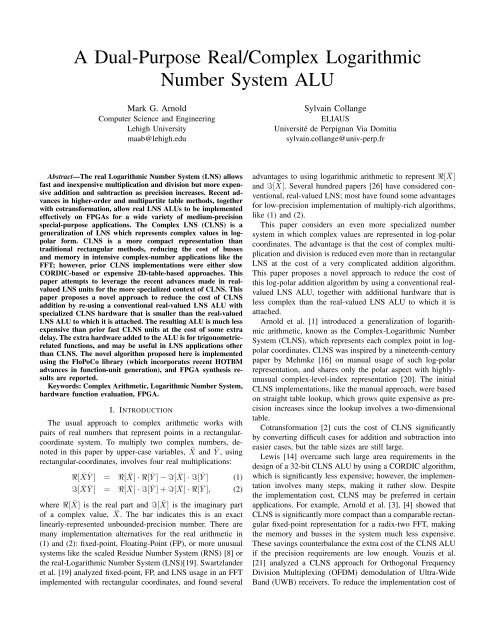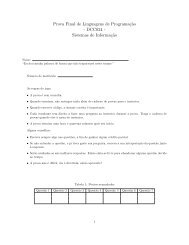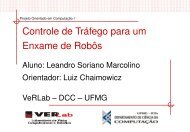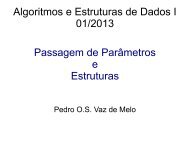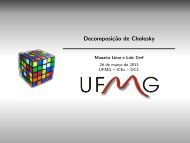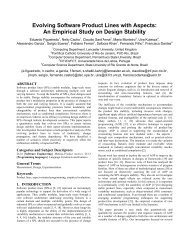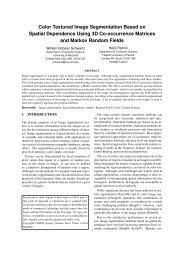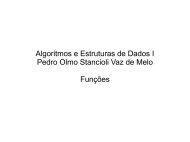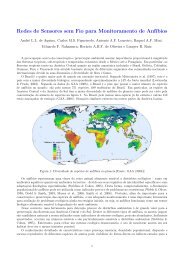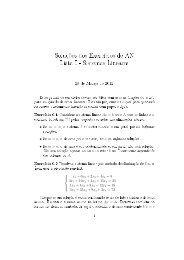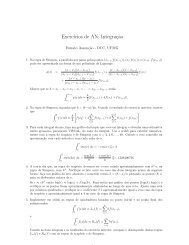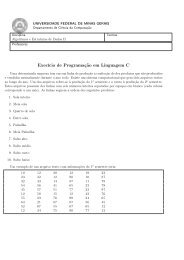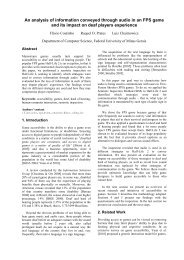A Dual-Purpose Real/Complex Logarithmic Number System ALU
A Dual-Purpose Real/Complex Logarithmic Number System ALU
A Dual-Purpose Real/Complex Logarithmic Number System ALU
You also want an ePaper? Increase the reach of your titles
YUMPU automatically turns print PDFs into web optimized ePapers that Google loves.
A <strong>Dual</strong>-<strong>Purpose</strong> <strong>Real</strong>/<strong>Complex</strong> <strong>Logarithmic</strong><br />
<strong>Number</strong> <strong>System</strong> <strong>ALU</strong><br />
Mark G. Arnold<br />
Computer Science and Engineering<br />
Lehigh University<br />
maab@lehigh.edu<br />
Abstract—The real <strong>Logarithmic</strong> <strong>Number</strong> <strong>System</strong> (LNS) allows<br />
fast and inexpensive multiplication and division but more expensive<br />
addition and subtraction as precision increases. Recent advances<br />
in higher-order and multipartite table methods, together<br />
with cotransformation, allow real LNS <strong>ALU</strong>s to be implemented<br />
effectively on FPGAs for a wide variety of medium-precision<br />
special-purpose applications. The <strong>Complex</strong> LNS (CLNS) is a<br />
generalization of LNS which represents complex values in logpolar<br />
form. CLNS is a more compact representation than<br />
traditional rectangular methods, reducing the cost of busses<br />
and memory in intensive complex-number applications like the<br />
FFT; however, prior CLNS implementations were either slow<br />
CORDIC-based or expensive 2D-table-based approaches. This<br />
paper attempts to leverage the recent advances made in realvalued<br />
LNS units for the more specialized context of CLNS. This<br />
paper proposes a novel approach to reduce the cost of CLNS<br />
addition by re-using a conventional real-valued LNS <strong>ALU</strong> with<br />
specialized CLNS hardware that is smaller than the real-valued<br />
LNS <strong>ALU</strong> to which it is attached. The resulting <strong>ALU</strong> is much less<br />
expensive than prior fast CLNS units at the cost of some extra<br />
delay. The extra hardware added to the <strong>ALU</strong> is for trigonometricrelated<br />
functions, and may be useful in LNS applications other<br />
than CLNS. The novel algorithm proposed here is implemented<br />
using the FloPoCo library (which incorporates recent HOTBM<br />
advances in function-unit generation), and FPGA synthesis results<br />
are reported.<br />
Keywords: <strong>Complex</strong> Arithmetic, <strong>Logarithmic</strong> <strong>Number</strong> <strong>System</strong>,<br />
hardware function evaluation, FPGA.<br />
I. INTRODUCTION<br />
The usual approach to complex arithmetic works with<br />
pairs of real numbers that represent points in a rectangularcoordinate<br />
system. To multiply two complex numbers, denoted<br />
in this paper by upper-case variables, ¯ X and ¯ Y , using<br />
rectangular-coordinates, involves four real multiplications:<br />
ℜ[ ¯ X ¯ Y ] = ℜ[ ¯ X] · ℜ[ ¯ Y ] − ℑ[ ¯ X] · ℑ[ ¯ Y ] (1)<br />
ℑ[ ¯ X ¯ Y ] = ℜ[ ¯ X] · ℑ[ ¯ Y ] + ℑ[ ¯ X] · ℜ[ ¯ Y ], (2)<br />
where ℜ[ ¯ X] is the real part and ℑ[ ¯ X] is the imaginary part<br />
of a complex value, ¯ X. The bar indicates this is an exact<br />
linearly-represented unbounded-precision number. There are<br />
many implementation alternatives for the real arithmetic in<br />
(1) and (2): fixed-point, Floating-Point (FP), or more unusual<br />
systems like the scaled Residue <strong>Number</strong> <strong>System</strong> (RNS) [8] or<br />
the real-<strong>Logarithmic</strong> <strong>Number</strong> <strong>System</strong> (LNS)[19]. Swartzlander<br />
et al. [19] analyzed fixed-point, FP, and LNS usage in an FFT<br />
implemented with rectangular coordinates, and found several<br />
Sylvain Collange<br />
ELIAUS<br />
Université de Perpignan Via Domitia<br />
sylvain.collange@univ-perp.fr<br />
advantages to using logarithmic arithmetic to represent ℜ[ ¯ X]<br />
and ℑ[ ¯ X]. Several hundred papers [26] have considered conventional,<br />
real-valued LNS; most have found some advantages<br />
for low-precision implementation of multiply-rich algorithms,<br />
like (1) and (2).<br />
This paper considers an even more specialized number<br />
system in which complex values are represented in log-polar<br />
coordinates. The advantage is that the cost of complex multiplication<br />
and division is reduced even more than in rectangular<br />
LNS at the cost of a very complicated addition algorithm.<br />
This paper proposes a novel approach to reduce the cost of<br />
this log-polar addition algorithm by using a conventional realvalued<br />
LNS <strong>ALU</strong>, together with additional hardware that is<br />
less complex than the real-valued LNS <strong>ALU</strong> to which it is<br />
attached.<br />
Arnold et al. [1] introduced a generalization of logarithmic<br />
arithmetic, known as the <strong>Complex</strong>-<strong>Logarithmic</strong> <strong>Number</strong><br />
<strong>System</strong> (CLNS), which represents each complex point in logpolar<br />
coordinates. CLNS was inspired by a nineteenth-century<br />
paper by Mehmke [16] on manual usage of such log-polar<br />
representation, and shares only the polar aspect with highlyunusual<br />
complex-level-index representation [20]. The initial<br />
CLNS implementations, like the manual approach, were based<br />
on straight table lookup, which grows quite expensive as precision<br />
increases since the lookup involves a two-dimensional<br />
table.<br />
Cotransformation [2] cuts the cost of CLNS significantly<br />
by converting difficult cases for addition and subtraction into<br />
easier cases, but the table sizes are still large.<br />
Lewis [14] overcame such large area requirements in the<br />
design of a 32-bit CLNS <strong>ALU</strong> by using a CORDIC algorithm,<br />
which is significantly less expensive; however, the implementation<br />
involves many steps, making it rather slow. Despite<br />
the implementation cost, CLNS may be preferred in certain<br />
applications. For example, Arnold et al. [3], [4] showed that<br />
CLNS is significantly more compact than a comparable rectangular<br />
fixed-point representation for a radix-two FFT, making<br />
the memory and busses in the system much less expensive.<br />
These savings counterbalance the extra cost of the CLNS <strong>ALU</strong><br />
if the precision requirements are low enough. Vouzis et al.<br />
[21] analyzed a CLNS approach for Orthogonal Frequency<br />
Division Multiplexing (OFDM) demodulation of Ultra-Wide<br />
Band (UWB) receivers. To reduce the implementation cost of
such CLNS applications, Vouzis et al. [22] proposed using a<br />
Range-Addressable Lookup Table (R<strong>ALU</strong>T), similar to [17].<br />
II. REAL-V<strong>ALU</strong>ED LNS<br />
The format of the real-valued LNS [18] has a base-b<br />
(usually, b = 2) logarithm (consisting of kL signed integer<br />
bits and fL fractional bits) to represent the absolute value of<br />
a real number and often an additional sign bit to allow for<br />
that real to be negative. We can describe the ideal logarithmic<br />
transformation and the quantization with distinct notations. For<br />
an arbitrary non-zero real, ¯x, the ideal (infinite precision) LNS<br />
value is xL = log b |¯x|. The exact linear ¯x has been transformed<br />
into an exact but non-linear xL, which is then quantized as<br />
ˆxL = ⌊xL2 fL + 0.5⌋2 −fL . In analogy to the FP number system,<br />
the kL integer bits behave like an FP exponent (negative<br />
exponents mean smaller than unity; positive exponents mean<br />
larger than unity); the fL fractional bits are similar to the FP<br />
mantissa. Multiplication or division simply require adding or<br />
subtracting the logarithms and exclusive-ORing the sign bits.<br />
To compute real LNS sums, a conventional LNS <strong>ALU</strong><br />
computes a special function, known as sb(z) = log b(1 + b z ),<br />
which, in effect, increments the LNS representation by 1.0.<br />
(The s reminds us this function is only used for sums when the<br />
sign bits are the same.) The LNS addition algorithm starts with<br />
xL = log b |¯x| and yL = log b |¯y| already in LNS format. The<br />
result, tL = log b(¯x+¯y) is computed as tL = yL+sb(xL−yL),<br />
which is justified by the fact that ¯t = ¯x + ¯y = ¯y(¯x/¯y + 1),<br />
even though such a step never occurs in the hardware. Since<br />
¯x + ¯y = ¯y + ¯x, we can always choose zL = −|xL − yL| [18]<br />
by simultaneously choosing the maximum of xL and yL. In<br />
other words, tL = max(xL, yL) + sb(−|xL − yL|), thereby<br />
restricting z < 0.<br />
Analogously to sb, there is a similar function to compute<br />
the logarithm of the differences with tL = max(xL, yL) +<br />
db(−|xL − yL|), where db(z) = log b |1 − b z |. The decision<br />
whether to compute sb or db is based on the signs of the real<br />
values.<br />
Early LNS implementations [18] used ROM to lookup ˆsb<br />
and ˆ db achieving moderate (fL = 12 bits) accuracy. More<br />
recent methods [11], [12], [13], [23], [24] can obtain accuracy<br />
near single-precision floating point at reasonable cost. The goal<br />
here is to leverage the recent advances made in real-valued<br />
LNS units for the more specialized context of CLNS.<br />
III. COMPLEX LOGARITHMIC NUMBER SYSTEM<br />
CLNS uses a log-polar approach for ¯ X �= 0 in which we<br />
define, for hardware simplicity,<br />
log b( ¯ X) = X = XL + Xθ · i, (3)<br />
where XL = log b( � ℜ[ ¯ X] 2 + ℑ[ ¯ X] 2 ) is the logarithm (base<br />
b) of the length of a vector in the complex plane and −π <<br />
Xθ ≤ π is the angle of that vector 1 . This can be converted<br />
1 Unless b = e, logb in this paper is defined slightly differently than the<br />
typical definition ln( ¯ X)/ ln(b) used in complex analysis.<br />
back exactly to rectangular form:<br />
ℜ[ ¯ X] = b XL cos(Xθ)<br />
ℑ[ ¯ X] = b XL sin(Xθ).<br />
In a practical implementation, both the logarithm and angle<br />
will be quantized:<br />
ˆXL = ⌊XL2 fL + 0.5⌋2 −fL<br />
ˆXθ = ⌊Xθ2 fθ+2 /π + 0.5⌋2 −fθ .<br />
We scale the angle by 4/π so that the quantization near<br />
the unit circle will be roughly the same in the angular and<br />
radial axes when fL = fθ while allowing the complete circle<br />
of 2π radians to be represented by a power of two. The<br />
rectangular value, ˜ X, represented by the quantized CLNS has<br />
the following real and imaginary parts:<br />
ℜ[ ˜ X] = b ˆ XL cos(π/4 ˆ Xθ)<br />
ℑ[ ˜ X] = b ˆ XL sin(π/4 ˆ Xθ).<br />
To summarize our notation, an arbitrary-precision complex<br />
value ¯ X �= 0 is transformed losslessly to its ideal CLNS<br />
representation, X. Quantizing X to ˆ X produces an absolute<br />
error perceived by the user in the rectangular system as<br />
| ¯ X − ˜ X|.<br />
<strong>Complex</strong> multiplication and division are trivial in CLNS.<br />
Given the exact CLNS representations, X and Y , the result of<br />
multiplication, Z = X + Y , can be computed by two parallel<br />
adders:<br />
ZL = XL + YL<br />
(7)<br />
Zθ = (Xθ + Yθ) mod 2π.<br />
The modular operation for the imaginary part is not strictly<br />
necessary, but reduces the range of angles that the hardware<br />
needs to accept. In the quantized system, this reduction comes<br />
at no cost in the underlying binary adder because of the 4/π<br />
scaling.<br />
For example, if ¯ X = −1 + i and ¯ Y = 4i, the b = 2 polarlogarithmic<br />
representations are XL = 0.5 log b(1 2 + 1 2 ) =<br />
0.5, Xθ = 3π/4 and YL = 0.5 log b(4 2 ) = 2.0, Yθ = π/2. The<br />
representation of the product is computed simply as ZL =<br />
XL + YL = 0.5 + 2.0 = 2.5 and Zθ = Xθ + Yθ = 3π/4 +<br />
π/2 = 5π/4. We can verify manually that this is correct: ¯ Z =<br />
b 2.5 (cos(5π/4) + i sin(5π/4)) = 4 √ 2(− √ 2/2 − √ 2/2i) =<br />
−4 − 4i.<br />
The conjugate of the value is represented by the conjugate<br />
of the representation, which can be formed by negating Zθ.<br />
For example, ¯ Z∗ = −4 + 4i is represented as Z∗ θ = −5π/4<br />
with the same ZL as ¯ Z. The negative can be formed by adding<br />
π to Zθ. Thus, − ¯ Z = 4 + 4i is represented as Zθ = π/4 with<br />
the same ZL.<br />
Division is like multiplication, except the representations<br />
are subtracted. For example, ¯ Z = ¯ X/ ¯ Y = (−1 + i)/(4i) =<br />
0.25 + 0.25i is computed as ZL = 0.5 − 2.0 = −1.5, Zθ =<br />
3π/4 − π/2 = π/4. Again, a superfluous conversion back<br />
to rectangular form, Z = b−1.5 (cos(π/4) + i sin(π/4)) =<br />
1/(2 √ 2)( √ 2/2 + √ 2/2i) = 0.25 + 0.25i, verifies this calculation.<br />
(4)<br />
(5)<br />
(6)
The difficult issue for all variations of LNS is addition and<br />
subtraction. Like conventional LNS, CLNS utilizes ¯ X + ¯ Y =<br />
¯Y ( ¯ Z + 1), where ¯ Z = ¯ X/ ¯ Y . This is valid for all complex<br />
values, except when ¯ X = − ¯ Y , a case that can be handled<br />
specially, as in real LNS.<br />
The complex-addition logarithm, Sb(Z) is a function [16]<br />
that accepts a complex argument, Z, the log-polar representation<br />
of ¯ Z, and returns the corresponding representation<br />
of ¯ Z + 1. Thus, to find the representation, T of the sum,<br />
¯T = ¯ X + ¯ Y simply involves<br />
T = Y + Sb(X − Y ), (8)<br />
which is implemented by two subtractors, a complex approximation<br />
unit, and two adders:<br />
TL = YL + ℜ[Sb(X − Y )]<br />
Tθ = (Yθ + ℑ[Sb(X − Y )]) mod 2π.<br />
The major cost in this circuit is the complex Sb unit. Subtraction<br />
simply requires adding πi to Y before performing (8).<br />
IV. NOVEL ADDITION ALGORITHM<br />
The complex addition logarithm, Sb(Z), has the same<br />
algebraic definition as its real-valued (sb(z)) counterpart, and<br />
simple algebra on the complex Z = ZL + iZθ reveals the<br />
underlying polar conversion required to increment a CLNS<br />
value by one:<br />
Sb(Z) = log b(1 + b Z )<br />
= log b(1 + b iZθ+ZL )<br />
= log b(1 + (cos(Zθ) + i sin(Zθ))b ZL )<br />
= log b(1 + cos(Zθ)b ZL + i sin(Zθ)b ZL ).<br />
(9)<br />
(10)<br />
This complex function can have its real and imaginary parts<br />
computed separately. In all of the prior CLNS literature [3],<br />
[4], [14], the real part2 is derived from (10) as:<br />
��<br />
ℜ(Sb(Z)) = logb (1 + cos(Zθ)bZL) 2 �<br />
+ (sin(Zθ)bZL) 2<br />
�<br />
= log b<br />
= log b<br />
� 1+2 cos(Zθ)b Z L +(cos(Zθ)b Z L ) 2 +(sin(Zθ)b Z L) 2<br />
� 2<br />
1+2 cos(Zθ)b ZL +(cos 2 (Zθ)+sin 2 (Zθ))b 2ZL = log b (1+2 cos(Zθ)b Z L +b 2Z L )<br />
2<br />
and the complex part is derived from (10) as:<br />
2<br />
,<br />
�<br />
(11)<br />
ℑ(Sb(Z)) = arctan(1 + cos(Zθ)b ZL , sin(Zθ)b ZL ), (12)<br />
where arctan(x, y) is the four-quadrant function, like<br />
atan2(y,x) in many programming languages. To produce<br />
¯X + ¯ Y = −1 + 5i given ¯ X = −1 + i and ¯ Y = 4i similar<br />
to the earlier examples, the inputs are represented by X =<br />
0.5 + 3π/4i, Y = 2.0 + π/2i, and the quotient is represented<br />
by Z = −1.5 + π/4i. Since sin(π/4) = cos(π/4) = √ 2/2,<br />
ℜ[Sb(Z)] = 0.5 · log 2(1 + 2 · 2 −1.5√ 2/2 + 2 −3 )<br />
= log 2( √ 26/4) ≈ 0.350<br />
ℑ[Sb(Z)] = arctan(1 + b −1.5√ 2/2, b −1.5√ 2/2)<br />
= arctan(1.25, 0.25) ≈ 0.197,<br />
2 [2] has a typo in which cos(Zθ)b Z L should have been 2 cos(Zθ)b Z L.<br />
(13)<br />
thus from (9), the result is:<br />
T = (2.0 + π/2i) + (log 2( √ 26) − 2.0)<br />
+ arctan(1.25, 0.25)i)<br />
= log 2( √ 26) + (arctan(1.25, 0.25)) + π/2)i<br />
≈ 2.350220 + 1.768191i.<br />
(14)<br />
This is correct since √ 26·cos(Tθ)+ √ 26·sin(Tθ)i ≈ −1+5i.<br />
In the prior literature, the functions (11) and (12) are<br />
computed directly from the complex Z, either using fast, but<br />
costly, simple lookup [21], or less expensive methods like<br />
cotransformation [2], CORDIC [14] or content-addressable<br />
memory [22]. The proposed approach uses a different derivation<br />
in which the real and imaginary parts are manipulated<br />
separately. Unlike the prior literature, in the proposed technique<br />
the real values in the intermediate computations are<br />
represented as conventional LNS real values; the angles remain<br />
as scaled fixed-point values at every step. The advantages of<br />
the proposed technique are lower cost and the ability to reuse<br />
the same hardware for both real- and complex-LNS operations.<br />
In order to use this novel approach, a different derivation from<br />
(10) is required, while still considering this a single complex<br />
function of a complex variable:<br />
Sb(Z) = log b(1 + b Z )<br />
= log b(1 + sgncos(Zθ)b logcos(Zθ) b ZL<br />
+i · sgnsin(Zθ)b logsin(Zθ) b ZL ),<br />
(15)<br />
where sgncos(Zθ) and sgnsin(Zθ) are the signs of the<br />
respective real-valued trigonmetric functions and where<br />
logcos(Zθ) = log b | cos(Zθ)| and logsin(Zθ) = log b | sin(Zθ)|<br />
are real-valued functions compatible with a real-valued LNS<br />
<strong>ALU</strong>. For simplicity, (15) ignores the trivial cases, when Zθ is<br />
a multiple of π/2, which cause sin(Zθ) or cos(Zθ) to be zero.<br />
These cases are resolved in Table I. In order to calculate the<br />
complex-valued function (15) using a conventional real LNS,<br />
there are two cases, (−π/2 < Zθ < π/2 and (Zθ < −π/2<br />
or Zθ > π/2)), that choose whether the “1+” operation is<br />
implemented with the real sb function or the real db function.<br />
Case 1 (−π/2 < Zθ < π/2) is when “1+” means a sum (sb)<br />
is computed:<br />
Case 1.<br />
Sb(Z) = log b((1 + b logcos(Zθ)+ZL )<br />
+i · sgnsin(Zθ)b logsin(Zθ)+ZL )<br />
= log b(b sb(logcos(Zθ)+ZL)<br />
+i · sgnsin(Zθ)b logsin(Zθ)+ZL ).<br />
(16)<br />
Case 2 (Zθ < −π/2 or Zθ > π/2) is when ”1+” means a<br />
difference (db) is computed:<br />
Case 2.<br />
Sb(Z) = log b((1 − b logcos(Zθ)+ZL )<br />
+i · sgnsin(Zθ)b logsin(Zθ)+ZL )<br />
= log b(b db(logcos(Zθ)+ZL)<br />
+i · sgnsin(Zθ)b logsin(Zθ)+ZL ).<br />
(17)<br />
Up to this point, instead of giving separate real and imaginary<br />
parts, we have described a complex function equivalent to<br />
(10) in a novel way that eventually will be amenable to being
computed with a conventional real LNS <strong>ALU</strong>. Of course, to<br />
use such an <strong>ALU</strong>, it will be necessary to compute the real and<br />
imaginary parts separately. In Case 1 (−π/2 < Zθ < π/2),<br />
the real part of (16) can be described as:<br />
ℜ(Sb(Z))<br />
� �<br />
sb(logcos(Zθ)+ZL)<br />
b<br />
= ℜ logb +i · sgnsin(Zθ)blogsin(Zθ)+ZL ��<br />
�√ �<br />
= logb b2sb(logcos(Zθ)+ZL) + b2(logsin(Zθ)+ZL) = 1<br />
2 logb(b2sb(logcos(Zθ)+ZL) 2(logsin(Zθ)+ZL)<br />
�<br />
+ b )<br />
2(logsin(Zθ)+ZL)<br />
b<br />
= 1<br />
2 log b<br />
+sb(2(sb(logcos(Zθ)+ZL)−(logsin(Zθ)+ZL)))<br />
= logsin(Zθ) + ZL+<br />
1<br />
2 sb(2(sb(logcos(Zθ) + ZL) − (logsin(Zθ) + ZL))).<br />
(18)<br />
There is a similar derivation from (17) for Case 2 (Zθ < −π/2<br />
or Zθ > π/2):<br />
ℜ(Sb(Z))<br />
� �<br />
db(logcos(Zθ)+ZL)<br />
b<br />
= ℜ logb +i · sgnsin(Zθ)blogsin(Zθ)+ZL ��<br />
�√ �<br />
= logb b2db(logcos(Zθ)+ZL) + b2(logsin(Zθ)+ZL) = 1<br />
2 logb(b2db(logcos(Zθ)+ZL) 2(logsin(Zθ)+ZL)<br />
�<br />
+ b )<br />
2(logsin(Zθ)+ZL)<br />
b<br />
= 1<br />
2 log b<br />
+sb(2(db(logcos(Zθ)+ZL)−(logsin(Zθ)+ZL)))<br />
= logsin(Zθ) + ZL+<br />
1<br />
2 sb(2(db(logcos(Zθ) + ZL) − (logsin(Zθ) + ZL))).<br />
(19)<br />
The subexpression −(logsin(Zθ) + ZL) in (18) and (19)<br />
becomes ∞ when Zθ = 0. This case, in fact, is trivially<br />
ℜ(Sb(Z)) = sb(ZL), which is equivalent to ℜ(Sb(Z)) =<br />
sb(logcos(Zθ) + ZL) when Zθ = 0. Summarizing the cases<br />
for the real part in our novel method, we have:<br />
⎧ℜ(Sb(Z))<br />
=<br />
logsin(Zθ) + ZL+<br />
1<br />
2<br />
⎪⎨<br />
sb(2(sb(logcos(Zθ) + ZL) − (logsin(Zθ) + ZL)))<br />
−π/2 < Zθ < 0 or 0 < Zθ < π/2<br />
sb(logcos(Zθ) + ZL), Zθ = 0<br />
logsin(Zθ) + ZL+<br />
⎪⎩<br />
1<br />
2 sb(2(db(logcos(Zθ) + ZL) − (logsin(Zθ) + ZL)))<br />
Zθ < −π/2 or Zθ > π/2.<br />
(20)<br />
The imaginary part uses the four-quadrant arctangent. The<br />
computation of the four-quadrant arctangent [25] depends on<br />
the signs of its two arguments:<br />
⎧<br />
⎪⎨<br />
− arctan(x, −y), y < 0<br />
π − arctan(−y/x), y ≥ 0, x < 0<br />
arctan(x, y) =<br />
⎪⎩<br />
arctan(y/x), y ≥ 0, x > 0<br />
π/2, y > 0, x = 0.<br />
�<br />
�<br />
(21)<br />
Eliminating the recursion in (21), and noting the value passed<br />
to the one-argument arctangent is now always non-negative,<br />
we have<br />
⎧<br />
⎪⎨<br />
arctan(x, y) =<br />
⎪⎩<br />
−π + arctan(|y|/|x|), y < 0, x < 0<br />
− arctan(|y|/|x|), y < 0, x > 0<br />
π − arctan(|y|/|x|), y ≥ 0, x < 0<br />
arctan(|y|/|x|), y ≥ 0, x > 0<br />
−π/2, y < 0, x = 0<br />
π/2, y > 0, x = 0.<br />
(22)<br />
It is obvious for the range of Zθ involved that y =<br />
sin(Zθ)b ZL < 0 when Zθ < 0. The condition when x =<br />
1 + cos(Zθ)b ZL < 0 is slightly more complicated, involving<br />
cos(Zθ)b ZL < −1, a condition that can only happen when<br />
sgncos(Zθ) < 0 (i.e., Zθ < −π/2 or Zθ > π/2) and<br />
| cos(Zθ)b ZL | > 1. In LNS, the latter condition is equivalent to<br />
logcos(Zθ) + ZL > 0. The opposite condition x > 0 happens<br />
when the cosine is positive, (−π/2 < Zθ < π/2), or when<br />
cos(Zθ)b ZL > −1. In LNS, the latter condition is equivalent<br />
to logcos(Zθ) + ZL < 0. Combining these conditions with<br />
(16), (17) and (22), we have:<br />
⎧ℑ(Sb(Z))<br />
=<br />
�<br />
| sin(Zθ)b<br />
−π + arctan<br />
ZL |<br />
|1+cos(Zθ)bZ �<br />
, L |<br />
Zθ < 0 and (Zθ < −π/2 or Zθ > π/2)<br />
and logcos(Zθ) + ZL � > 0<br />
| sin(Zθ)b<br />
− arctan<br />
Z �<br />
L |<br />
,<br />
⎪⎨<br />
⎪⎩<br />
π − arctan<br />
|1+cos(Zθ)b Z L |<br />
(Zθ < 0 and (−π/2 < Zθ < π/2))<br />
or logcos(Zθ) + ZL � < 0<br />
,<br />
� | sin(Zθ)b Z L |<br />
|1+cos(Zθ)b Z L |<br />
Zθ ≥ 0 and (Zθ < −π/2 or Zθ > π/2)<br />
and logcos(Zθ) + ZL � > 0<br />
arctan<br />
,<br />
� | sin(Zθ)b Z L |<br />
|1+cos(Zθ)b Z L |<br />
(Zθ ≥ 0 and (−π/2 < Zθ < π/2))<br />
or logcos(Zθ) + ZL < 0<br />
−π/2,<br />
Zθ < 0 and (Zθ < −π/2 or Zθ > π/2)<br />
and logcos(Zθ) + ZL = 0<br />
π/2,<br />
Zθ ≥ 0 and (Zθ < −π/2|Zθ > π/2)<br />
and logcos(Zθ) + ZL = 0 .<br />
Simplifying the conditions, we have:<br />
⎪⎨<br />
⎪⎩<br />
(23)<br />
ℑ(Sb(Z)) ⎧ =<br />
�<br />
| sin(Zθ)b<br />
−π + arctan<br />
ZL |<br />
|1+cos(Zθ)bZ �<br />
, L |<br />
Zθ < −π/2 and logcos(Zθ) + ZL � > 0<br />
| sin(Zθ)b<br />
− arctan<br />
Z �<br />
L |<br />
,<br />
|1+cos(Zθ)b Z L |<br />
Zθ < 0 and (Zθ > −π/2 or logcos(Zθ) + ZL < 0)<br />
π − arctan<br />
arctan<br />
� | sin(Zθ)b Z L |<br />
|1+cos(Zθ)b Z L |<br />
� | sin(Zθ)b Z L |<br />
|1+cos(Zθ)b Z L |<br />
�<br />
,<br />
Zθ > π/2 and logcos(Zθ) + ZL > 0<br />
�<br />
,<br />
Zθ ≥ 0 and (Zθ < π/2 or logcos(Zθ) + ZL < 0)<br />
−π/2, Zθ < −π/2 and logcos(Zθ) + ZL = 0<br />
π/2, Zθ > π/2 and logcos(Zθ) + ZL = 0.<br />
(24)
The result produced for | sin(Zθ)b ZL |/|1 + cos(Z)b ZL | in<br />
LNS depends on whether sb or db is required to produce 1 +<br />
cos(Zθ)b ZL , which again depends on the sign of the cosine<br />
(either positive with −π/2 < Zθ < π/2 or negative with<br />
Zθ < −π/2, Zθ > π/2).<br />
�<br />
| sin(Zθ)b<br />
log<br />
ZL |<br />
|1+cos(Zθ)bZ �<br />
=<br />
L |<br />
⎧<br />
⎪⎨<br />
⎪⎩<br />
− (sb(logcos(Zθ) + ZL) − (logsin(Zθ) + ZL)) ,<br />
−π/2 < Zθ < π/2<br />
− (db(logcos(Zθ) + ZL) − (logsin(Zθ) + ZL)) ,<br />
Zθ < −π/2 or Zθ > π/2.<br />
(25)<br />
Note that the intermediate expression in (25) is the negative<br />
of that used for the real part in the CLNS <strong>ALU</strong> derived above.<br />
In two cases, we need to expand the arctangent derivation into<br />
sb and db subcases so that we can substitute the intermediate<br />
expression into the arctangent.<br />
⎧ℑ(Sb(Z))<br />
=<br />
−π + arctan<br />
⎪⎨<br />
⎪⎩<br />
�<br />
| sin(Zθ)b ZL |<br />
|1+cos(Zθ)bZL |<br />
�<br />
,<br />
Zθ < −π/2 and logcos(Zθ) + ZL > 0<br />
�<br />
| sin(Zθ)b<br />
− arctan<br />
ZL |<br />
|1+cos(Zθ)bZ �<br />
, L |<br />
Zθ ≤ −π/2 and<br />
(Zθ > −π/2 or logcos(Zθ) + ZL < 0)<br />
�<br />
| sin(Zθ)b<br />
− arctan<br />
ZL |<br />
|1+cos(Zθ)bZ �<br />
, L |<br />
−π/2 < Zθ < 0 and<br />
(Zθ > −π/2 or logcos(Zθ) + ZL < 0)<br />
�<br />
| sin(Zθ)b<br />
π − arctan<br />
ZL |<br />
|1+cos(Zθ)bZ �<br />
, L |<br />
Zθ > π/2 and logcos(Zθ) + ZL > 0<br />
�<br />
| sin(Zθ)b<br />
arctan<br />
ZL |<br />
|1+cos(Zθ)bZ �<br />
, L |<br />
Zθ ≥ π/2 and<br />
(Zθ < π/2 or logcos(Zθ) + ZL < 0)<br />
�<br />
| sin(Zθ)b<br />
arctan<br />
ZL |<br />
|1+cos(Zθ)bZ �<br />
, L |<br />
−π/2,<br />
π/2,<br />
0 < Zθ ≤ π<br />
Zθ < −π/2 and logcos(Zθ) + ZL = 0<br />
Zθ > π/2 and logcos(Zθ) + ZL = 0.<br />
(26)<br />
Again eliminating impossible conditions,<br />
ℑ(Sb(Z)) ⎧ =<br />
−π + arctan<br />
⎪⎨<br />
⎪⎩<br />
�<br />
| sin(Zθ)b ZL |<br />
|1+cos(Zθ)bZL |<br />
�<br />
,<br />
Zθ < −π/2 and logcos(Zθ) + ZL � > 0<br />
| sin(Zθ)b<br />
− arctan<br />
Z �<br />
L |<br />
,<br />
|1+cos(Zθ)b Z L |<br />
Zθ ≤ −π/2 and logcos(Zθ) + ZL � < 0<br />
| sin(Zθ)b<br />
− arctan<br />
Z �<br />
L |<br />
,<br />
|1+cos(Zθ)b Z L |<br />
−π/2 < Zθ �<br />
< 0<br />
| sin(Zθ)b<br />
π − arctan<br />
ZL |<br />
|1+cos(Zθ)bZ �<br />
, L |<br />
Zθ > π/2 and logcos(Zθ) + ZL � > 0<br />
| sin(Zθ)b<br />
arctan<br />
Z �<br />
L |<br />
,<br />
arctan<br />
|1+cos(Zθ)b Z L |<br />
Zθ ≥ π/2 and logcos(Zθ) + ZL �<br />
< 0<br />
,<br />
�<br />
| sin(Zθ)b ZL |<br />
|1+cos(Zθ)bZL |<br />
0 < Zθ ≤ π/2<br />
−π/2, Zθ < −π/2 and logcos(Zθ) + ZL = 0<br />
π/2, Zθ > π/2 and logcos(Zθ) + ZL = 0.<br />
(27)<br />
There is a similar problem as in (20) about the singularity<br />
of logsin(Zθ) in the case of Zθ = 0. Again, this is trivial<br />
since ℑ[Sb(Z)] = 0 in this case. Taking this into account, we<br />
can substitute the LNS computation of the quotient into the<br />
arctangent:<br />
ℑ(Sb(Z)) =<br />
⎧<br />
⎪⎨<br />
⎪⎩<br />
−π + arctan(b −(db(logcos(Zθ)+ZL)−(logsin(Zθ)+ZL)) ),<br />
Zθ ≤ −π/2 and logcos(Zθ) + ZL > 0<br />
− arctan(b −(db(logcos(Zθ)+ZL)−(logsin(Zθ)+ZL)) ),<br />
Zθ ≤ −π/2 and logcos(Zθ) + ZL < 0<br />
− arctan(b −(sb(logcos(Zθ)+ZL)−(logsin(Zθ)+ZL)) ),<br />
−π/2 < Zθ < 0<br />
0, Zθ = 0<br />
π − arctan(b −(db(logcos(Zθ)+ZL)−(logsin(Zθ)+ZL)) ),<br />
Zθ > π/2 and logcos(Zθ) + ZL > 0<br />
arctan(b −(db(logcos(Zθ)+ZL)−(logsin(Zθ)+ZL)) ),<br />
Zθ > π/2 and logcos(Zθ) + ZL < 0<br />
arctan(b −(sb(logcos(Zθ)+ZL)−(logsin(Zθ)+ZL)) ),<br />
0 < Zθ ≤ π/2<br />
−π/2, Zθ < −π/2 and logcos(Zθ) + ZL = 0<br />
π/2, Zθ > π/2 and logcos(Zθ) + ZL = 0.<br />
(28)<br />
V. IMPLEMENTATION<br />
Figure 1 shows a straightforward implementation of (20)<br />
and (28). The operation of the sign-logic unit is summarized<br />
in Table I. This logic operates in two modes: complex mode,<br />
which is the focus of this paper, and real mode (which uses<br />
the sb/db unit to perform traditional LNS arithmetic). In real<br />
mode, Zθ = 0 is used to represent a positive sign, and<br />
Zθ = −π is used to represent a negative sign. Given the<br />
angular quantization, the LNS sign bit corresponds to the most<br />
significant bit of ˆ Zθ, with the other bits masked to zero.<br />
In order to minimize the cost of CLNS hardware implementation,<br />
we exploit several techniques to transform the<br />
arguments to the function-approximation units into limited
TABLE I<br />
TABLE OF REQUIRED CLNS <strong>ALU</strong> SIGN LOGIC.<br />
Mode Zθ logcos(Zθ) + ZL 4Q correct LNS op Mux<br />
logcos(Zθ) + ZL > 0 −π + arctan db 0<br />
Zθ ≤ −π/2 logcos(Zθ) + ZL = 0 −π/2 db 0<br />
logcos(Zθ) + ZL < 0 − arctan db 0<br />
−π/2 < Zθ < 0 − arctan sb 0<br />
<strong>Complex</strong> Zθ = 0 0 sb 1<br />
0 < Zθ < π/2 arctan sb 0<br />
logcos(Zθ) + ZL > 0 π − arctan db 0<br />
Zθ ≥ π/2 logcos(Zθ) + ZL = 0 π/2 db 0<br />
logcos(Zθ) + ZL < 0 arctan db 0<br />
Zθ = 0 0 sb 1<br />
<strong>Real</strong> logcos(Zθ) + ZL < 0 0 db 1<br />
Zθ �= 0 logcos(Zθ) + ZL > 0 −π db 1<br />
Fig. 1. CLNS <strong>ALU</strong> with <strong>Complex</strong> and <strong>Real</strong> Modes.<br />
ranges where approximation is affordable. Assuming b = 2,<br />
the reduction for the addition logarithm is typical of real-LNS<br />
implementations:<br />
⎧<br />
⎪⎨<br />
0, x < −2<br />
s2(x) =<br />
⎪⎩<br />
wez<br />
log2(1 + 2x ), −2wez < x ≤ 0<br />
x + s2(−x), 0 < x < 2wez x, x ≥ 2wez ,<br />
(29)<br />
where wez ≤ kL describes the wordsize needed to reach<br />
the “essential zero” [18], which is the least negative value<br />
that causes log 2(1 + 2 x ) to be quantized to zero. We use<br />
similar range reduction for the subtraction logarithm when<br />
z is far from zero, together with cotransformation [23] for<br />
z near zero. The scaled arctangent is nearly equal to s2 for<br />
negative arguments (only because we choose b = 2 and 4/π<br />
scaling), although the treatment of positive arguments reflects<br />
the asymptotic nature of the arctangent:<br />
⎧<br />
⎪⎨<br />
0, x < −2<br />
a2(x) =<br />
⎪⎩<br />
wez<br />
4/π arctan(2x ), −2wez < x ≤ 0<br />
2 − a2(−x), 0 < x < 2wez 2, x ≥ 2wez .<br />
(30)<br />
The range reduction for the trigonmetric functions involves<br />
one case for each octant:<br />
⎧<br />
c2(−x), x < 0<br />
⎪⎨<br />
logcos(π/4x), 0 ≤ x < 1<br />
d2(2 · c2(2 − x)), 1 ≤ x < 2<br />
c2(x) =<br />
(31)<br />
d2(2 · c2(x − 2)), 2 ≤ x < 3<br />
⎪⎩<br />
c2(4 − x), 3 ≤ x < 4<br />
c2(x − 8), x ≥ 4.<br />
We can reuse (31) to yield logsin(π/4x) = c2(x + 2) as well<br />
as logcos(π/4x) = c2(x).<br />
VI. DIRECT FUNCTION LOOKUP<br />
There are several possible hardware realizations for (20) and<br />
(28). When fL and fθ are small, it is possible to use a direct<br />
table lookup for ˆsb, ˆ db, âb and ĉb. This implementation allows<br />
round-to-nearest results for each functional unit, reducing<br />
roundoff errors in (20) and (28). Figure 2 shows the errors<br />
(σ ≈ 0.05) in computing the real part (20) as a function of ZL<br />
and Zθ with such round-to-nearest tables when fL = fθ = 7.<br />
Figure 3 shows errors (σ ≈ 0.002) for the imaginary part (28).<br />
The errors in these and later figures spike dramatically near<br />
ZL = 0, Zθ = ±π because of the inherent singularities in<br />
Sb(Z) at these points.<br />
The memory requirements for each of the ˆsb, ˆ db, âb directlookup<br />
tables (with a ˆ ZL input) is 2 wez+fL words, assuming<br />
reduction rules like (29) and (30), which allow the interval<br />
spanned by these tables to be as small as (−2 wez , 0). The<br />
trigonometric tables, with ˆ Zθ inputs, require 2 2+fθ words<br />
because −2 < ˆ Zθ < 2 (equivalent to −π < Zθ < π) and<br />
two integer bits are sufficient to cover this dynamic range.<br />
Instead of the more involved (31) rule used in later sections,<br />
cb(x) = cb(−x) suffices for direct lookup.
Fig. 2. Error in ℜ[Sb(Z)] using Direct Lookup with fL = fθ = 7.<br />
Fig. 3. Error in ℑ[Sb(Z)] using Direct Lookup with fL = fθ = 7.<br />
Since there are two instances of trigonometric tables and<br />
four instances of other tables in Figure 1, the total number of<br />
words required for naïve direct lookup is 2 f+3 (2 wez−1 + 1)<br />
assuming f = fL = fθ. Table II shows the number of words<br />
required by prior 2D-direct lookup methods [4], [22] compared<br />
to our proposed 1D-direct lookup implementation of (20) and<br />
(28). Savings occur for f ≥ 5, and grow exponentially more<br />
beneficial as f increases.<br />
For f ≥ 8, the cost of direct implementation grows<br />
exponentially, although at a slower rate than the prior methods.<br />
One approach to reduce table size is to use interpolation on<br />
a smaller table. The cost of a simple linear interpolation unit<br />
is related to the size of the region of the interpolation and<br />
to the absolute maximum value of the second derivative in<br />
that region. Table III gives the range and the derivatives for<br />
the required functions. The db function is not considered as<br />
it may be computed via cotransformation [23]. It is clear that<br />
logsin has a singularity similar to db, which is the reason we<br />
avoid evaluating it directly and instead have chosen to use<br />
the relationship cos(x − π/2) = sin(x) = � 1 − cos 2 (x) in<br />
(31). Because of the quantization of ĉ2, this approximation is<br />
imperfect very near the singularity, but appears to deal with<br />
most cases adequately.<br />
The maximum value (≈ 1.7) of the second derivative for<br />
logcos in its restricted range is large; however, the fact the<br />
range is restricted to 0 ≤ x ≤ 1 mitigates this. It is well<br />
TABLE II<br />
MEMORY FOR PRIOR AND NOVEL DIRECT METHODS.<br />
f [4] [22] Novel Saving<br />
4 6886 597 640 -7%<br />
5 27862 2916 1280 56%<br />
6 127742 20203 2560 87%<br />
7 566761 115249 5120 95%<br />
8 2512012 604578 10240 98%<br />
known [13] that the absolute maximum value (≈ 0.17) of the<br />
second derivative of sb is modest; however, this table needs to<br />
cover a much larger range than logcos. The absolute maximum<br />
value (≈ 0.15) of the arctangent-exponential function is about<br />
the same as s2 and its range is equally large. These values<br />
predict that interpolation from a uniformly-spaced table will<br />
be the best choice for cb, but would require significant memory<br />
for sb and ab. Instead, it would be more effective to optimize<br />
the sb and ab approximations into subdomains, as explained in<br />
the next section. Such subdomains are effective for sb and ab<br />
(because their absolute second derivatives span many binades<br />
from 0.0 to over 0.1), but are not effective for cb (because<br />
its absolute second derivative only varies one binade from<br />
π 2 /(16 ln(b)) to π 2 /(8 ln(b))).<br />
VII. OPTIMIZED FUNCTION-UNIT SYNTHESIS<br />
The novel CLNS algorithm requires several special-function<br />
units, which should be optimized to minimize the cost of the<br />
units, especially as the precision, f, increases. These units<br />
were generated using enhanced versions of existing tools to<br />
simplify generating and optimizing synthesizable VHDL for<br />
these units.<br />
A. FPLibrary<br />
FPLibrary is an implementation of floating-point and LNS<br />
operators for FPGAs developed by Detrey and De Dinechin<br />
[11]. It provides addition, multiplication, division and squareroot<br />
operators for both systems, with a user-defined precision,<br />
scaling up to IEEE single precision. LNS addition and subtraction<br />
are implemented using multipartite tables, generated<br />
in VHDL for every combination of parameters. It was later<br />
extended by Vouzis et al. to perform the LNS subtraction using<br />
cotransformation [23].<br />
B. HOTBM<br />
A method for function evaluation using tables and polynomial<br />
interpolations called HOTBM was developed by Detrey<br />
and De Dinechin [12]. The input domain of the function to<br />
be evaluated is split into regular intervals, and the function is<br />
approximated by a minimax polynomial inside each interval.<br />
Polynomials are evaluated as a sum of terms, each term<br />
being computed either by a powering unit and a multiplier<br />
or a table. The size of each component (table, multiplier<br />
and powering unit) is tuned to balance the rounding error<br />
and avoid unnecessary computations. As an implementation<br />
of this method, the authors also provide a tool written in C++<br />
which generates hardware function evaluators in synthesizable<br />
VHDL. An exhaustive search in the parameter space is performed<br />
during generation to estimate the most area- and delayefficient<br />
design.<br />
C. FloPoCo<br />
FloPoCo, for Floating-Point Cores, is intended to become<br />
a superset of both FPLibrary and HOTBM. Like HOTBM,<br />
it consists of a C++ program generating VHDL code. In<br />
addition to the usual floating-point and fixed-point arithmetic
TABLE III<br />
TABLE OF FUNCTIONS AND DERIVATIVES.<br />
function 1st derivative 2nd derivative Range |Max 2nd|<br />
sb(x)<br />
b x<br />
bx +1<br />
b<br />
ln(b)<br />
x<br />
(bx +1) 2 −wez < x ≤ 0 ln(b)/4 ≈ 0.173<br />
logsin(π/4x)<br />
π π<br />
cot( 4 ln(b) 4 x)<br />
−π 2<br />
16 ln(b) sin( π 4 x)2 logcos(π/4x) −<br />
0 ≤ x ≤ 1.0 ∞<br />
π π<br />
tan( 4 ln(b) 4 x)<br />
−π 2<br />
16 ln(b) cos( π 4 x)2<br />
0 ≤ x ≤ 1.0<br />
π 2<br />
4/π arctan(b<br />
≈ 1.78<br />
8 ln(b) x )<br />
4 ln(b) b<br />
π<br />
x<br />
b2x +1<br />
4b x ln(b) 2<br />
π(1+b2x ) − 8b3x ln(b) 2<br />
π(1+b2x ) 2 −wez < x ≤ 0<br />
ln(b) 2<br />
≈ 0.153<br />
π<br />
TABLE IV<br />
PARAMETERS USED FOR SYNTHESIS.<br />
Size Param Order<br />
k f t j ˆsb âb ĉb<br />
5 8 -8 5 1 1 1<br />
5 10 -8 6 1 1 1<br />
5 12 -8 7 1 1 1<br />
5 14 -4 8 1 1 2<br />
5 16 -4 9 1 1 1<br />
5 18 -4 10 2 2 2<br />
5 20 -4 11 2 2 2<br />
operators, it can generate more exotic operators, such as<br />
long accumulators [10] or constant multipliers [9]. It aims<br />
at taking advantage of FPGA flexibility in order to increase<br />
efficiency and accuracy compared to a naïve translation of a<br />
software algorithm to an FPGA circuit. Although it includes an<br />
implementation of HOTBM for fixed-point function evaluation<br />
and a whole range of floating-point operators, the LNS part<br />
of FPLibrary was not ported to FloPoCo by its developers.<br />
D. A CLNS coprocessor<br />
We extended the FloPoCo library with real LNS arithmetic.<br />
To perform the LNS addition, the input domain of sb is split<br />
into three subdomains : [−2 wez , −8[, [−8, −4[ and [−4, 0[,<br />
where wez is such that sb evaluates to zero in ] − ∞, −2 wez [.<br />
This is done to account for the exponential nature of sb(z) for<br />
smaller values z. The same partitioning was used in FPLibrary.<br />
We then use an HOTBM operator to evaluate sb inside<br />
each interval. This partitioning scheme allows significant area<br />
improvements compared to a regular partitioning as performed<br />
by HOTBM.<br />
Likewise, the domain of db is split into intervals. The<br />
lower range [−2 wez , t[ is evaluated using several HOTBM<br />
operators, just like sb. As we get closer to the singularity<br />
of db near 0, the function becomes harder to evaluate using<br />
polynomial approximations. The upper range [t, 0[ is evaluated<br />
using cotransformation. This approach is similar to the one<br />
used by Vouzis et al. in FPLibrary [23].<br />
We used this extended FloPoCo library to generate the<br />
VHDL code for the functional units in a CLNS <strong>ALU</strong> at<br />
various precisions. One component was generated for each<br />
function involved in the CLNS addition. <strong>Real</strong> LNS functions<br />
sb and db are generated by the extended FloPoCo. The function<br />
logcos(π/4x) is implemented as a HOTBM component, and<br />
4/π arctan(2 x ) is evaluated using several HOTBM components<br />
with the same input domain decomposition as sb.<br />
Given the complexity of HOTBM and the influence of<br />
synthesizer optimizations, it is difficult to estimate precisely<br />
the best value of the db threshold t, cotransformation parameter<br />
j, and HOTBM order using simple formulas. We<br />
synthesized the individual units for a Virtex-4 LX25 with<br />
Xilinx ISE 10.1 using various parameters. For each precision<br />
tested, the combination of parameters yielding the smallest<br />
area on this configuration was determined. Table IV sums<br />
up the parameters obtained. We plan to automate this search<br />
in the future by using heuristics relying on the latency/area<br />
estimation framework integrated in FloPoCo.<br />
E. Time/Area Tradeoff<br />
The synthesis results are listed in detail in Tables V and<br />
VI, where αs, α s/d, αc and αa are the areas of the respective<br />
units, and τs, τ s/d, τc and τa are the corresponding delays. One<br />
implementation option would be to follow the combinational<br />
architecture in Figure 1, in which case the area is roughly αs+<br />
2α s/d + αc + αa because one db together with ab implement<br />
both logcos and logsin. (We neglect the area of four fixed-point<br />
adders, a mux and the control logic.) The delay is 2τ s/d +τc +<br />
max(τa, τs).<br />
An alternative, which saves area (α s/d+αc+αa), uses three<br />
cycles to complete the computation (so that the same hybrid<br />
unit may be reused for all three sb/db usages). The total area<br />
is less than double the area α s/d of a standalone real LNS<br />
unit. The delay is roughly 3τ s/d, since the hybrid unit has the<br />
longest delay. Despite using only about half the area of the<br />
combinational alternative, the three-cycle approach produces<br />
the result in about the same time as the combinational option.<br />
It is hard to make direct comparisons, but the CORDIC<br />
implementation of CLNS reported in [14] uses ten stages.<br />
Some of those stages have relatively large multipliers, similar<br />
to what is generated for our circuit by FloPoCo. If such<br />
CORDIC stages have delay longer than 0.3 of our proposed<br />
clock cycle, our approach would be as fast or faster than [14].<br />
Figure 4 shows the errors (σ ≈ 0.05) in computing the<br />
real part (20) as a function of ZL and Zθ using the f = 7<br />
function units generated by FloPoCo. This is roughly similar to<br />
the errors when computing the direct-lookup with the roundto-nearest<br />
method shown in Figure 2. In contrast, Figure 5<br />
shows errors (σ ≈ 0.007) for the imaginary part (28), which<br />
is significantly more than the errors for direct-lookup roundto-nearest<br />
shown in Figure 3, especially for zL > 0. To<br />
determine the cause of this, simulations were run in which<br />
each of the function units generated by FloPoCo were replaced
TABLE V<br />
AREA OF FUNCTION APPROXIMATION UNITS (SLICES) ON XILINX<br />
VIRTEX-4.<br />
k f αs α s/d αc αa αs + 2α s/d α s/d + αc<br />
+αc + αa<br />
+αa<br />
5 8 62 130 23 49 394 202<br />
5 10 117 227 55 125 751 407<br />
5 12 195 436 86 173 1326 695<br />
5 14 364 854 133 329 2534 1316<br />
5 16 559 1384 228 560 4115 2172<br />
5 18 941 2418 300 752 6829 3470<br />
5 20 1295 4230 398 1100 11253 5728<br />
TABLE VI<br />
LATENCY OF FUNCTION APPROXIMATION UNITS (NS) ON XILINX<br />
VIRTEX-4.<br />
k f τs τ s/d τc τa 2τ s/d+τc 3τ s/d<br />
+max(τa,τs)<br />
5 8 6.969 16.817 5.556 6.843 46.159 50.451<br />
5 10 12.161 24.021 6.78 12.563 67.385 72.063<br />
5 12 14.171 25.86 11.846 14.38 77.946 77.58<br />
5 14 16.55 31.045 13.04 16.689 91.819 93.135<br />
5 16 18.4 33.231 16.662 18.947 102.071 99.693<br />
5 18 23.975 36.652 16.795 20.244 114.074 109.956<br />
5 20 23.233 39.312 18.124 19.935 119.981 117.936<br />
with round-to-nearest units. When both logsin and logcos are<br />
computed with round-to-nearest, the imaginary result, shown<br />
in Figure 6, has smaller errors (σ ≈ 0.004) which are much<br />
closer to those of Figure 3. Our conjecture is that using<br />
sin(x) = � 1 − cos 2 (x) contributes to the extra errors in<br />
Figure 5, which are then magnified by the slightly larger<br />
roundoff errors from all the other FloPoCo units.<br />
VIII. LOW-ACCURACY METHOD<br />
Some complex-number applications, like OFDM [21], may<br />
produce acceptable results even using low-accuracy techniques,<br />
i.e., where there is a large systematic error in the<br />
Fig. 4. Error in ℜ[Sb(Z)] using FloPoCo with fL = fθ = 7.<br />
Fig. 5. Error in ℑ[Sb(Z)] using FloPoCo with fL = fθ = 7.<br />
Fig. 6. Error in ℑ[Sb(Z)] using nearest sin/cos with fL = fθ = 7.<br />
result due to the method even if performed with large word<br />
sizes. Mitchell [15] described two techniques for very-lowaccuracy<br />
logarithmic arithmetic: one obtains the logarithm,<br />
x = log 2(¯x), and the other obtains the antilogarithm, 2 x .<br />
Mitchell approximates the logarithm by determining the position<br />
of the leading significant bit in ¯x and shifting a corre-<br />
sponding amount:<br />
⎧<br />
⎪⎨<br />
m(¯x) =<br />
⎪⎩<br />
2¯x − 2, 0.5 ≤ ¯x ≤ 1.0<br />
4¯x − 3, 0.25 ≤ ¯x ≤ 0.5<br />
...<br />
2 n · ¯x − n + 1, 2 −n ≤ ¯x ≤ 2 −n+1 .<br />
(32)<br />
The case of ¯x = 0 is undefined since in that case it is<br />
impossible to find a leading one. For the inverse problem,<br />
Mitchell uses:<br />
2 x ≈ m −1 (x) = 2 int(x) · (frac(x) + 1). (33)<br />
where int(x) is the integer part and frac(x) is the fractional<br />
part. Arnold [5] suggested that Mitchell’s method can be used<br />
as a low-accuracy (around four bits), but not necessarily lowprecision<br />
(i.e., not necessarily performed with small word sizes<br />
since the cost of (32) and (33) only increase linearly with<br />
word size), approximation for the addition and subtraction<br />
logarithms:<br />
�<br />
−1 m (−x), x ≤ 0<br />
s2(x) ≈<br />
(34)<br />
d2(x) ≈<br />
⎧<br />
⎪⎨<br />
⎪⎩<br />
x + m −1 (x), x > 0<br />
−m −1 (−x + 1), x ≤ −1<br />
x + m(−x), −1 < x < 0<br />
m(x), 0 < x < 1<br />
x + m −1 (x − 1), x ≥ 1.<br />
(35)<br />
The d function is undefined at ¯x = 0. Because the scaled<br />
arctangent is highly similar in value to s2(x), it is reasonable<br />
to use a similar approximation:<br />
a2(x) ≈<br />
� m −1 (x), x ≤ 0<br />
2 − m −1 (−x), x > 0.<br />
(36)<br />
For the remaining functions, we can use range reduction<br />
like (31) together with an approximation like c2(x) ≈<br />
m −1 (2 · m(|x|) − 89/128)/2 for −0.5 < x < 0.5, where<br />
the −89/128 is an approximation to 2 log 2(π/2). Because<br />
Mitchell’s method can be implemented without tables, it<br />
is possible to perform these operations with very minimal<br />
hardware. For example, [7] reports f = 8 serial-arithmetic<br />
implementations of Mitchell’s method using about twenty<br />
CLBs.
IX. CONCLUSIONS<br />
A new addition algorithm for complex log-polar addition<br />
was proposed that is based around an existing real-valued<br />
LNS <strong>ALU</strong>. The proposed design allows this <strong>ALU</strong> to continue<br />
to be used for real arithmetic, in addition to the special<br />
complex functionality described in this paper. The novel CLNS<br />
algorithm requires extra function units for log-trigonometric<br />
functions, which may have application beyond complex polar<br />
representation. Three implementation options for the novel<br />
special units were considered: medium-accuracy direct lookup,<br />
higher-accuracy interpolation (as generated by a tool called<br />
FloPoCo), and low-accuracy Mitchell’s method. The errors resulting<br />
from the former two accurate alternatives were studied.<br />
(The suitability of the low-accuracy Mitchell’s method for a<br />
given application requires extensive simulative study beyond<br />
the scope here.) As expected, round-to-nearest direct lookup<br />
tables give the lowest roundoff errors. We show that the errors<br />
in the FloCoPo implementation can be reduced by using a<br />
more accurate logsin unit than the one we proposed here based<br />
on Pythagorian calculations from logcos.<br />
We compared these implementations of our novel CLNS algorithm<br />
to all known prior approaches. Our novel method has<br />
speed comparable to CORDIC, and uses orders-of-magnitude<br />
less area than prior 2D-table lookup approaches. As such,<br />
our approach provides a good compromise between speed and<br />
area. Considering that CLNS offers smaller bus widths than<br />
conventional rectangular representation of complex numbers,<br />
our proposed algorithm makes the use of this rather unusual<br />
number system in practical algorithms, like the OFDM, more<br />
feasible.<br />
In the course of implementing the CLNS <strong>ALU</strong>, we uncovered<br />
and corrected several bugs in the HOTBM implementation<br />
of FloPoCo. We also made it easier to use by<br />
allowing the user to select the input range and scale of the<br />
target function instead of having to map its ranges manually<br />
to [0, 1[ → [−1, 1[. Hence, our work contributes to the maturity<br />
of the FloPoCo tool beyond the field of LNS.<br />
X. ACKNOWLEDGMENTS<br />
We would like to thank the referees, especially referee 1,<br />
for the very helpful comments.<br />
REFERENCES<br />
[1] M. G. Arnold, T. A. Bailey, J. R. Cowles and M. D. Winkel, “Arithmetic<br />
Co-transformations in the <strong>Real</strong> and <strong>Complex</strong> <strong>Logarithmic</strong> <strong>Number</strong><br />
<strong>System</strong>s,” 13th IEEE Symposium on Computer Arithmetic, Asilomar,<br />
California, pp. 190-199, July 1997.<br />
[2] M. G. Arnold, T. A. Bailey, J. R. Cowles and M. D. Winkel, “Arithmetic<br />
Co-transformations in the <strong>Real</strong> and <strong>Complex</strong> <strong>Logarithmic</strong> <strong>Number</strong><br />
<strong>System</strong>s,” IEEE Transactions on Computers, vol. 47, no. 7, pp. 777-<br />
786, July 1998.<br />
[3] M. G. Arnold, T. A. Bailey, J. R. Cowles, C. Walter, “Analysis of<br />
<strong>Complex</strong> LNS FFTs,” Signal Processing <strong>System</strong>s SIPS 2001: Design<br />
and Implementation, Francky Catthoor and Marc Moonen, Editors, IEEE<br />
Press, Antwerp, Belgium, pp. 58-69, 26-28 September 2001.<br />
[4] M. Arnold, T. Bailey, J. Cowles and C. Walter, “Fast Fourier Transforms<br />
using the <strong>Complex</strong> Logarithm <strong>Number</strong> <strong>System</strong>,” Journal of VLSI Signal<br />
Processing, Springer, vol 33, pp. 325-335, 2003.<br />
[5] M. G. Arnold, “LPVIP: A Low-Power ROM-less <strong>ALU</strong> for Low-<br />
Precision LNS,” 14th International Workshop on Power and Timing<br />
Modeling, Optimization, Simulation, Santorini, Greece, LNCS 3254, pp.<br />
675-684, 15-17 Sept. 2004.<br />
[6] M. G. Arnold, “Approximating Trigonometric Functions with the Laws<br />
of Sines and Cosines Using the <strong>Logarithmic</strong> <strong>Number</strong> <strong>System</strong>,” 8th<br />
EuroMicro Symposium on Digital <strong>System</strong>s Design, pp. 48-53, Porto,<br />
Portugal, 30 Aug. - 3 Sept. 2005.<br />
[7] M. Arnold, P. Vouzis, “A Serial <strong>Logarithmic</strong> <strong>Number</strong> <strong>System</strong> <strong>ALU</strong>,” 10th<br />
EuroMicro Conference on Digital <strong>System</strong> Design, pp. 151-154, Lübeck,<br />
Germany, 27-31 August, 2007.<br />
[8] N. Burgess, “Scaled and Unscaled Residue <strong>Number</strong> <strong>System</strong> to Binary<br />
Conversion Techniques Using the Residue <strong>Number</strong> <strong>System</strong>,” 13th IEEE<br />
Symposium on Computer Arithmetic, Asilomar, CA, pp. 250–257, Aug.<br />
1997.<br />
[9] N. Brisebarre, F. de Dinechin, and J. M. Muller, “Integer and Floating-<br />
Point Constant Multipliers for FPGAs,” Application-specific <strong>System</strong>s,<br />
Architectures and Processors, IEEE, pp. 239-244, 2008.<br />
[10] F. de Dinechin, B. Pasca, O. Cret¸ and R. Tudoran, “An FPGA-specific<br />
Approach to Floating-Point Accumulation and Sum-of-Products,” Field-<br />
Programmable Technology, IEEE, pp. 33-40, 2008.<br />
[11] J. Detrey and F. de Dinechin, “A Tool For Unbiased Comparison<br />
Between <strong>Logarithmic</strong> and Floating-Point Arithmetic,” Journal of VLSI<br />
Signal Processing, Springer, vol. 49, no. 1, pp. 161–175, 2007.<br />
[12] J. Detrey, F. de Dinechin, “Table-Based Polynomials for Fast Hardware<br />
Function Evaluation,” 16th International Conference on Applicationspecific<br />
<strong>System</strong>s, Architectures and Processors, IEEE, Samos, Greece,<br />
pp. 328-333, July 2005.<br />
[13] D. M. Lewis, “An Architecture for Addition and Subtraction of Long<br />
Word Length <strong>Number</strong>s in the <strong>Logarithmic</strong> <strong>Number</strong> <strong>System</strong>,” IEEE<br />
Transactions on Computers, vol. 39, pp. 1325-1336, Nov. 1990.<br />
[14] D. M. Lewis, “<strong>Complex</strong> <strong>Logarithmic</strong> <strong>Number</strong> <strong>System</strong> Arithmetic Using<br />
High Radix Redundant CORDIC Algorithms,” 14th IEEE Symposium<br />
on Computer Arithmetic, Adelaide, Australia, pp. 194-203, 14–16 April<br />
1999.<br />
[15] J. N. Mitchell, “Computer Multiplication and Division Using Binary<br />
Logarithms,” IEEE Transactions on Electronic Computers, vol. EC-11,<br />
pp. 512-517, August 1962.<br />
[16] R. Mehmke, “Additionslogarithmen für <strong>Complex</strong>e Grössen,” Zeitschrift<br />
für Mathematik und Physik, vol. 40, pp. 15-30, 1895.<br />
[17] R. Muscedere, V. S. Dimitrov, G. A. Jullien, and W. C. Miller, “Efficient<br />
Conversion from Binary to Multi-Digit Multidimensional <strong>Logarithmic</strong><br />
<strong>Number</strong> <strong>System</strong>s Using Arrays of Range Addressable Look-Up Tables,”<br />
13th International Conference on Application-specific <strong>System</strong>s, Architectures<br />
and Processors, San Jose, pp. 130-138, July 2002.<br />
[18] E. E. Swartzlander and A. G. Alexopoulos, “The Sign/Logarithm <strong>Number</strong><br />
<strong>System</strong>,” IEEE Transactions on Computers, vol. C-24, pp. 1238–<br />
1242, Dec 1975.<br />
[19] E. E. Swartzlander, et al., “Sign/Logarithm Arithmetic for FFT Implementation,”<br />
IEEE Transactions on Computers, vol. C-32, pp. 526–534,<br />
1983.<br />
[20] P. R. Turner, “<strong>Complex</strong> SLI Arithmetic: Representation, Algorithms and<br />
Analysis,” 11th Symposium on Computer Arithmetic, Windsor, Ontario,<br />
IEEE Computer Society Press, pp. 18-25, 29 June-4 July, 1993.<br />
[21] P. Vouzis, M. G. Arnold and V. Paliouras, “Using CLNS for FFTs in<br />
OFDM Demodulation of UWB Receivers,” IEEE International Symposium<br />
on Circuits and <strong>System</strong>s, Kobe, Japan, pp. 3954-3957, 23-26 May<br />
2005.<br />
[22] P. Vouzis and M. G. Arnold, “A Parallel Search Algorithm for CLNS<br />
Addition Optimization,” IEEE International Symposium on Circuits and<br />
<strong>System</strong>s, Kos, Greece, 21-24 May 2006.<br />
[23] P. Vouzis, S. Collange, M. Arnold, “Cotransformation Provides Area and<br />
Accuracy Improvement in an HDL Library for LNS Subtraction,” 10th<br />
EuroMicro Conference on Digital <strong>System</strong> Design, pp. 85-93, Lübeck,<br />
Germany, 27-31 August, 2007.<br />
[24] P. Vouzis, S. Collange, M. Arnold, “LNS Subtraction Using Novel<br />
Cotransformation and/or Interpolation,” IEEE 18th International Conference<br />
on Application-specific <strong>System</strong>s, Architectures and Processors,<br />
pp. 107-114, Montreal, Quebec, Canada, 9-11 July, 2007.<br />
[25] http://www.wikipedia.org/wiki/arctangent, cited 14<br />
Oct, 2008.<br />
[26] http://www.xlnsresearch.com.


